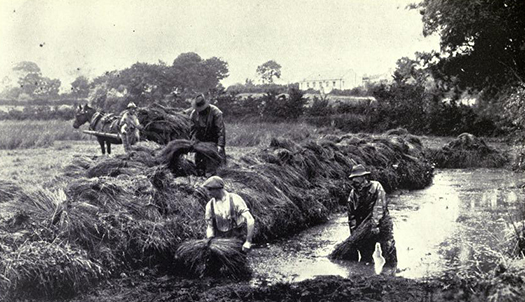
Clonakilty was known for the manufacture of linen, and to a lesser extent cotton. In 1837 the linen industry with its 400 looms provided employment to 1,000 people and weekly sales in the region of £300. However, at its height the industry frequently brought in £1,000 per week (Lewis, 1837). Clonakilty’s Linen Hall was erected by the Earl of Shannon to facilitate dealers in conducting their business.
Likewise, Rosscarbery and Skibbereen were centres of linen production, and the latter was also known for its wool. Anne Plumptre observed on a visit to Skibbereen in 1815 that
The lands about produce a good deal of flax, and manufactories both of linen and woollen are carried on…
The town had a ‘considerable trade, arising from the manufacture of woollen cloth, linen, checks and handkerchiefs’, but this had declined by 1837 (Lewis, 1837). Reasons for the decline in the industry included the rise of cotton – it was reported that the machinery used in cotton manufacture was superior to that of the linen, while linen produced in the north of Ireland was finer. In the 1860s there were attempts to revive the linen industry in Cork.
The by-product of flax production was flax-water from the ponds in which harvested flax was steeped in water (ideally from a river rather than a spring) until ready to be transported to buyers. The flax water had a pungent odour and could poison fish, though it was thought to have a positive effect if used on grass. By the 1860s anyone polluting the water with flax-water would be fined £10 (Fisheries Act, 5 and 6 Vict., c. 105). In some cases people also diverted streams for this purpose, which could also have a negative impact on the environment.
In August 1908, a case relating to flax-water was brought at the Rosscarbery Petty Sessions. The Cork Examiner reported that an individual had diverted a tributary of the Arigideen river into a pond and allowed the water to flow back into the river again, resulting in the death of trout that inhabited the river. Local officials explained that:
The result of this flax water going into a river is that it does not recover its effects on the fish for ten or, even, fifteen years.

